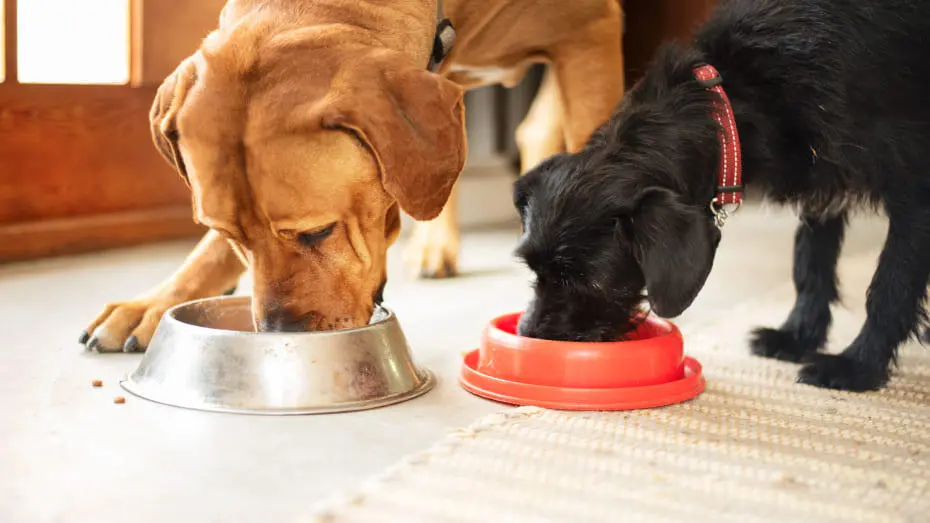
Our four-legged companions are members of our families, and we want to make sure they get the greatest nutrition possible so they may grow and enjoy a long and healthy life. Many dog owners are concerned about what goes into their pup’s food bowls and are actively investigating the finest dog food components available in commercial diets.
You can be certain that our Purina pet food contains 100% of the necessary nutrients your pet needs to flourish. If you want to learn more about our pet food, visit our every ingredient has a purpose and your questions matter sections, where we offer more information about our diets.
What ingredients are in dog food?

Dogs need 37 different nutrients, including water, proteins, lipids, carbs, vitamins, and minerals, since they are omnivores. All of these essential nutritional categories should be met by a commercial dog meal that uses high-quality dog food components.
Protein
Meat, chicken, fish, and even certain plant-based dog food components like corn gluten and soybean flour are all good sources of protein. Protein’s function is to give vital amino acids and protein subunits, all of which contribute to the maintenance of a healthy coat, skin, nails, muscles, tendons, ligaments, cartilage, and hormone synthesis.
Protein content varies widely throughout diets, ranging from a high of 30% in puppy chow to a low of 8% in senior meals. Prescription diets are an exception to this rule since they will include a variable quantity of protein based on the demands of various diseases.
Fats
Fats also originate from meats, poultry, fish and plant oils (especially flax and vegetable oils) (particularly flax and vegetable oils). Fats are crucial for a dog’s diet since they assist in regulating the dog’s temperature, reducing inflammation, and increasing vitamin absorption, to name a few of its numerous activities. In addition, lipids provide a significant amount of stored energy, almost twice as much as either carbs or proteins.
Fatty acids like omega-6, which are important for skin, coat, and membrane health, and omega-3, which assists in blood clotting and reduces inflammation, may both be found in fats.
Carbohydrates
Carbohydrates, which are found in plants and grains, are an excellent source of energy and may also improve digestion. Carbohydrates mainly come in the form of dog food components such as maize, soy, whole wheat, rice, oats, barley and peas. This kind of substance has earned a poor name in recent years, but if your dog doesn’t have any allergies or sensitivities, it’s safe for them to consume and may be quite useful.
Vitamins and minerals
Whenever you inspect the ingredients of your dog’s food, keep an eye out for the presence of vitamins and minerals. These amazing items aid in metabolic function, digestive health, and immunological defense, as well as bone development, blood coagulation, energy generation, and oxidant protection.
Biotin, pyridoxine, riboflavin, thiamine, and beta-carotene are all forms of vitamin B, and they’re some of the most crucial vitamins to have. Vitamin A is crucial for a dog’s skin and hair, while vitamin E is important for a strong immune system.
On the other hand, minerals are important for a healthy skeleton and nervous and muscular systems. L-carnitine is crucial because it aids in the transportation of fatty acids and in the cellular synthesis of energy, much like the critical minerals zinc, iron, potassium, calcium, and manganese.
Water
You should seek for meals that have a high moisture content since water is such a vital dog food element. In addition, you should provide them with enough of clean water to drink at all times.
Ingredients in dog food that you should watch out for
When looking at what’s in dog food, you should choose a diet that possesses the following:
- A whole source of animal protein should always be the first ingredient, such as fish, poultry or meat.
- A source of easily digestible carbohydrates like whole grains or vegetables.
- Healthy fats like chicken fats and salmon oils.
- Healthy nutrients such as omega-3 fatty acids, chondroitin and glucosamine.
- Natural preservatives like vitamins C and E.
A top tip is that the listed dog food ingredients run from highest to lowest so meat should always be the first ingredient. It’s best to avoid diets that have soya, grains or vegetable-based proteins listed first as these won’t have as much nutritional value.
What dog food ingredients to avoid
There are some ingredients which aren’t as healthy for your pup, so it’s best to avoid diets with:
- Artificial preservatives such as BHT, BHA and ethoxyquin.
- Diets that just list ‘meat’ or ‘meat-meal’ and aren’t specific about the protein source.
- Artificial colours and flavours, these may be listed as E numbers or ‘colourings/flavourings’.
The good news is that commercial dog food must adhere to stringent criteria and regulations about the kind of ingredients it can and cannot include to assure the safety of the product and that it provides enough nourishment for dogs throughout their whole lives. You can be confident that your dog is receiving all the nutrients it needs when you give it a full and balanced meal.
Talk to your doctor if your dog has any health issues or if you’re having trouble deciding which dog food is best for your pup. Based on your dog’s breed, nutritional requirements, and activity level, they’ll be able to provide a piece of well-informed advice.